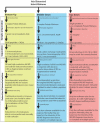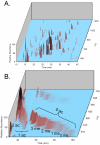Progress in epigenetic histone modification analysis by mass spectrometry for clinical investigations
- PMID: 26400466
- PMCID: PMC4830274
- DOI: 10.1586/14789450.2015.1084231
Progress in epigenetic histone modification analysis by mass spectrometry for clinical investigations
Abstract
Chromatin biology and epigenetics are scientific fields that are rapid expanding due to their fundamental role in understanding cell development, heritable characters and progression of diseases. Histone post-translational modifications (PTMs) are major regulators of the epigenetic machinery due to their ability to modulate gene expression, DNA repair and chromosome condensation. Large-scale strategies based on mass spectrometry have been impressively improved in the last decade, so that global changes of histone PTM abundances are quantifiable with nearly routine proteomics analyses and it is now possible to determine combinatorial patterns of modifications. Presented here is an overview of the most utilized and newly developed proteomics strategies for histone PTM characterization and a number of case studies where epigenetic mechanisms have been comprehensively characterized. Moreover, a number of current epigenetic therapies are illustrated, with an emphasis on cancer.
Keywords: cancer; chromatin; epigenetics; histone; histone variants; mass spectrometry; post-translational modifications; proteomics; translational medicine.
Figures






Similar articles
-
Recent Achievements in Characterizing the Histone Code and Approaches to Integrating Epigenomics and Systems Biology.Methods Enzymol. 2017;586:359-378. doi: 10.1016/bs.mie.2016.10.021. Epub 2017 Jan 6. Methods Enzymol. 2017. PMID: 28137571 Free PMC article. Review.
-
The contribution of mass spectrometry-based proteomics to understanding epigenetics.Epigenomics. 2016 Mar;8(3):429-45. doi: 10.2217/epi.15.108. Epub 2015 Nov 25. Epigenomics. 2016. PMID: 26606673 Review.
-
Quantification of SAHA-Dependent Changes in Histone Modifications Using Data-Independent Acquisition Mass Spectrometry.J Proteome Res. 2015 Aug 7;14(8):3252-62. doi: 10.1021/acs.jproteome.5b00245. Epub 2015 Jul 13. J Proteome Res. 2015. PMID: 26120868 Free PMC article.
-
Proteomics in chromatin biology and epigenetics: Elucidation of post-translational modifications of histone proteins by mass spectrometry.J Proteomics. 2012 Jun 27;75(12):3419-33. doi: 10.1016/j.jprot.2011.12.029. Epub 2012 Jan 3. J Proteomics. 2012. PMID: 22234360 Review.
-
Biochemical systems approaches for the analysis of histone modification readout.Biochim Biophys Acta. 2014 Aug;1839(8):657-68. doi: 10.1016/j.bbagrm.2014.03.008. Epub 2014 Mar 27. Biochim Biophys Acta. 2014. PMID: 24681439 Review.
Cited by
-
Global Level Quantification of Histone Post-Translational Modifications in a 3D Cell Culture Model of Hepatic Tissue.J Vis Exp. 2022 May 5;(183):10.3791/63606. doi: 10.3791/63606. J Vis Exp. 2022. PMID: 35604167 Free PMC article.
-
Novel detection of post-translational modifications in human monocyte-derived dendritic cells after chronic alcohol exposure: Role of inflammation regulator H4K12ac.Sci Rep. 2017 Sep 11;7(1):11236. doi: 10.1038/s41598-017-11172-6. Sci Rep. 2017. PMID: 28894190 Free PMC article.
-
Middle-down proteomics: a still unexploited resource for chromatin biology.Expert Rev Proteomics. 2017 Jul;14(7):617-626. doi: 10.1080/14789450.2017.1345632. Epub 2017 Jun 28. Expert Rev Proteomics. 2017. PMID: 28649883 Free PMC article. Review.
-
Mass Spectrometry to Study Chromatin Compaction.Biology (Basel). 2020 Jun 26;9(6):140. doi: 10.3390/biology9060140. Biology (Basel). 2020. PMID: 32604817 Free PMC article. Review.
-
Inter-proteomic posttranslational modifications of the SARS-CoV-2 and the host proteins ‒ A new frontier.Exp Biol Med (Maywood). 2021 Apr;246(7):749-757. doi: 10.1177/1535370220986785. Epub 2021 Jan 19. Exp Biol Med (Maywood). 2021. PMID: 33467896 Free PMC article. Review.
References
-
- Feinberg AP, Tycko B. The history of cancer epigenetics. Nature reviews. Cancer. 2004;4(2):143–153. - PubMed
-
- Laird PW. The power and the promise of DNA methylation markers. Nature reviews. Cancer. 2003;3(4):253–266. - PubMed
-
- Mattick JS, Makunin IV. Non-coding RNA. Human molecular genetics. 2006;15:R17–29. Spec No 1. - PubMed
-
- Jenuwein T, Allis CD. Translating the histone code. Science. 2001;293(5532):1074–1080. - PubMed
-
- Luger K, Mader AW, Richmond RK, Sargent DF, Richmond TJ. Crystal structure of the nucleosome core particle at 2.8 A resolution. Nature. 1997;389(6648):251–260. - PubMed
Publication types
MeSH terms
Grants and funding
LinkOut - more resources
Full Text Sources
Other Literature Sources
Miscellaneous
